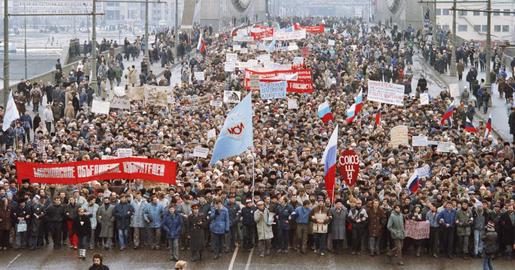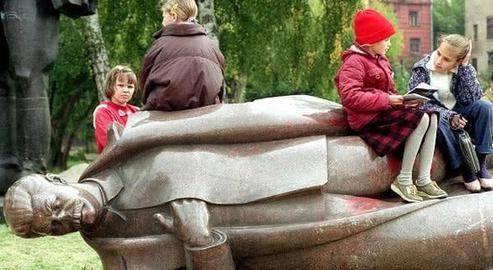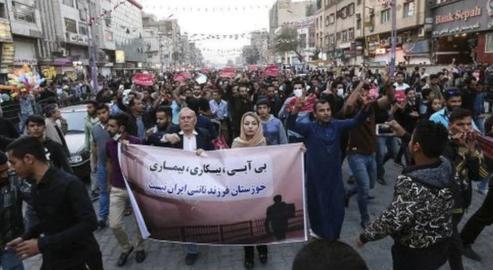In the three decades Ayatollah Khamenei has been Supreme Leader of the Islamic Republic, he has held views about the collapse of the Soviet Union that have shaped his rule. Iranians have been paying for these “lessons learned”, directly or indirectly.
What does Khamenei think about Russia? How has the fall of the Soviet Union reinforced his paranoia, and how far has Vladimir Putin’s Russia become his preferred model of governance and patronage?
In the first instalment of our new series “Iran and Russia”, IranWire studies the history of relations between the two countries.
***
Ayatollah Khamenei assumed the office of the Supreme Leader of the Islamic Republic on June 4, 1989. The Soviet Union collapsed on December 26, 1991. This event made a deep impression on Khamenei and his views on how to govern his own country. It also made him determined to prevent the Islamic Republic from meeting the same fate.
This intention was perhaps most clearly expressed in a speech Khamenei he delivered a decade later on July 10, 2000 at a meeting of high-level government officials, while Mohammad Khatami was the president of the Islamic Republic. “I have now reached the conclusion that the United States has devised a comprehensive plan to subvert the system of the Islamic Republic,” he declared. “This plan is an imitation of the one that led to the collapse of the former Soviet Union. US officials intend to carry out the same in Iran, and there are plentiful clues [evidencing this] in their selfish, often hasty remarks made during the past few years.”
Khamenei has lived with this fear for 30 years now. The ensuing paranoia has shaped both domestic policies, most keenly in the securitization of public affairs in Iran, and his foreign policy stances, particularly with regard to Iran-US relations. This constant fear of the US is reflected in almost every speech he makes, and has made the word “enemy” – rightly or wrongly – one of his most-used.
An Ingrained Fear of the “Enemy”
Dread of the US has become so ingrained in Khamenei’s psyche and language it did not subside even after the historic nuclear agreement was reached during the Obama administration. Both Iranian and American officials had worked hard to make the JCPOA a reality. But immediately after it was reached, Khamenei claimed the US intended to “infiltrate” Iran.
The Supreme Leader’s fear is that the United States is laying the groundwork to bring down the Islamic Republic. He appears to believe that the Soviet Union, a nuclear power, could not have broken up without an American conspiracy. But in the real world, i.e. the world outside the mind of Khomeini’s successor, the reasons for the collapse of the Soviet Union were different. As it happens, they bore a striking resemblance to what might one day in reality bring the Islamic Republic to an end: abuses of power, cover-ups and propaganda, and the prioritization of an outdated ideology over efficient governance.
The Soviet Union officially ceased to exist in December 1991. But its decline had arguably started on April 26, 1986, when an explosion at the Chernobyl Nuclear Power Plant in Ukraine released radioactive material equal to that of 100 nuclear weapons, spreading clouds of radioactive material across parts of Europe that would blight the lives of generations to follow.
Immediately after this disaster, Soviet officials scrambled obscure the evidence and suppress accurate information on the incident as far as possible. In those days it was easier to hide the truth. But, at the same time, the lack of access to the facts gave rise to fantastic rumors. For a while, people in the region believed that Chernobyl had been hit by an American strike.
Soviet leaders and security officials did their best to pretend the situation was normal. They were fairly successful in doing so until early 1988. Then, very slowly at first little by little, the facts began to seep out. The public lost confidence in Moscow and the groundwork was laid for the breakup of the Union of Soviet Socialist Republics.
Less than six years after Chernobyl, the people of Ukraine voted in favor of independence from the Soviet Union. This vote delivered the death blow to an already moribund bloc, which fell apart just 25 days later. Years afterward, Mikhail Gorbachev, the last leader of the Soviet Union, openly stated that the government’s lies about Chernobyl were among the main catalysts for the fall of what was once one of the world’s most powerful political entities.
Khamenei was obviously horrified by the fate of the Soviet Union. Despite this, his rule of Iran has mirrored that of its waning years. When Mohammad Khatami won the presidential election in 1997 on the promise of “reform”, normalizing relations with the West and easing tensions with the United States, it panicked him further. In one of his most important speeches during the Khatami era, Khamenei said: “As a person who since the beginning of this revolution until today has faced various issues... and as somebody who knows people, understands the words and is familiar with the global media propaganda, I have arrived at a conclusion that, in a nutshell, is this: there is a plot [to bring about] the collapse of the Islamic Republic.”
An Iranian Gorbachev?
Some people in Iran have compared Khatami to Gorbachev. Khamenei is aware of this, and has railed against it. “They have made a few mistakes,” he said in one speech shortly after the Soviet Union came apart. “Their first is that Mr. Khatami is not Gorbachev. The second is that Islam is not communism. The third is that the regime of the Islamic Republic is a regime of the people, not the dictatorship of the proletariat. The fourth is that Iran is an integrated country and, unlike the Soviet Union, is not made up of lands that are stitched together. The fifth is that the unique role of the religious and spiritual leader is no joke.”
Notably, praise for Russia only became a regular feature of Khamenei’s speeches shortly after he took over the leadership of the Islamic Republic. This comes as opposed to his unchanging hatred towards the West, especially the United States. In the same speech, he went on: “The architects of this scheme [that brought down the Soviet Union]... dream of the same thing for the Islamic Republic. They cannot imagine that if the Islamic Republic of Iran meets the same fate as that of Soviet Union it will become a country like today’s Russia. No, they think Iran will be as it was under the Pahlavi regime; they think it’s not nuclear, it’s not very scientifically advanced, it does not have a population of 300 million and it is not a vast country like Russia, which even today, is still nearly the biggest country in the world.”
Nuclear Power and Large Population as Defensive Shield
In the years that followed, Khamenei put nuclear power and population growth at the top of his internal list of priorities. The Islamic Republic launched its costly nuclear program only because of Russia. Khamenei also repeated –without regard for whether it made pragmatic or financial sense for Iran – the need to increase the domestic birth rate in almost every speech that he made. With some irony, nuclear sanctions and bad management of the economy have now created such a level of insecurity that many Iranians have lost confidence in the future and, as a consequence, are less willing to have children than they were even two decades ago.
Khamenei has so far failed in implementing his two favorite policies. But he also tried his luck, with some at least temporary success, defeating the popular appetite for fundamental reform. His speeches in the 1990s clearly showed his fear of democratic change, as well as of its once-most prominent proponent, Mohammad Khatami.
“I am really loath to bring up the name of our dear Khatami... in the same way as the Westerners who compare him to Gorbachev,” he said in another speech. “But they have made this comparison and have said another Gorbachev has taken power in Iran. Let us not forget that some people inside the country also liked this comparison and did not realize it is an insult. And, of course, they also did not understand the conspiracy behind this insult. I’m not talking about people with bad intentions, who know what’s happening and know what they’re after. There were some who did not bear ill will, but who did not understand what was happening and what the enemy wanted to do.”
In the years that followed, Khatami’s reform programs comprehensively defeated by Khamenei himself and his appointees. Khatami’s associates and the journalists and intellectuals who supported him were either imprisoned or forced into exile.
In 2011, years after the above speech by Khamenei, at a time the pro-democracy Green Movement protests had been violently suppressed and Khatami and his associates were under severe restrictions, General Mohammad Ali Jafari, commander of the Revolutionary Guards, explicitly confirmed what was going on in the Supreme Leader’s mind. “Because of the leadership of His Excellency Ayatollah Khamenei,” he said, “Western governments lost hope in destroying the Islamic Republic like they did the Soviet Union, and chose to destroy it from within.”
The general credited the “smart and wise management of the exalted Supreme Leader” for the failure of the reformist project. “In fact,” he said, “Imam Khamenei’s miracle was that he was able to control eight years of the reformist government, preventing them from going to the extreme. The conspiracy theory of the chain murders [a well-documented series of killings and disappearances of Iranian intellectuals and artists between 1988 and 1998] was intended to disable the Intelligence Ministry. But efforts by the reformists to end the supervision of the Guardian Council and increase the powers of the presidency failed. At the end of its eight years in power and despite the heavy blows it landed on the Islamic Revolution, the government of reforms did not make the structural changes to the Islamic Republic it had wanted.”
Learning the Wrong Lessons
What Khamenei saw in the collapse of Soviet Union in his early years as the Supreme Leader pushed him in a direction opposite to the interests and will of the Iranian people. This has manifested in repeated, undemocratic elections, state brutality, poverty, information suppression and street protests.
Nevertheless, Khamenei never conceded that he has acted as a dictator. In a meeting with students in the summer of 2012, one young attendee complained about censorship and the suppression of free speech in Iran. “I am not Stalin, making a series of statements and then bringing a group of people to make them into a theory,” Khamenei answered. However, exactly like in the Soviet Union under Stalin, his office then censored this exchange. It only leaked out due to the bravery and public-spiritedness of some of those present.
Ayatollah Khamenei is enamored with Russia today. He repeatedly talks about the Russian novels he has read, and praises the policies of the Russian President Vladimir Putin. “One of the areas that the two sides can cooperate is in the containment of the United States,” Khamenei told Putin when he visited Tehran in late 2015. He admires the Russian kleptocratic economy, its closed political structures and its security environment. Khamenei might consider the fate of the Soviet Union a cautionary tale, but he finds in present-day Russia a model to be imitated.
Related Coverage:
Nuclear Confrontation, Khamenei's Gift to Iran
Khamenei Appoints his Anti-JCPOA Relative as Iran’s New Nuclear Negotiator
Ayatollah Khamenei: Go Forth and Multiply!
Special Report: Khamenei’s Delusional Population Growth Policy Endangers Iran’s Future
The Future of Iran’s Caspian Sea Territory
The Tale Behind Putin’s Trip To Tehran
Lessons for Iranians from a Soviet Meltdown
A Little More East Than West: Iran and Russia
visit the accountability section
In this section of Iran Wire, you can contact the officials and launch your campaign for various problems




























comments